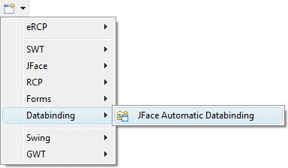 Supported for Eclipse 3.3
and above only
Supported for Eclipse 3.3
and above only Supported for Eclipse 3.3
and above only
Supported for Eclipse 3.3
and above onlyThe JFace Automatic Data Binding wizard can be used to create new user interface classes (Composites, Dialogs or Windows) complete with widgets, layouts and data bindings from arbitrary domain model (bean) classes.
To use the wizard, select the project source folder and package to contain the class. Then enter the class name and hit the Next button. If a domain class was selected when the wizard was opened, a default name for the new UI class will be generated.
The org.eclipse.swt.widgets.Composite class is the default superclass. You can select either org.eclipse.jface.dialogs.Dialog or org.eclipse.swt.widgets.Shell as alternative superclasses.
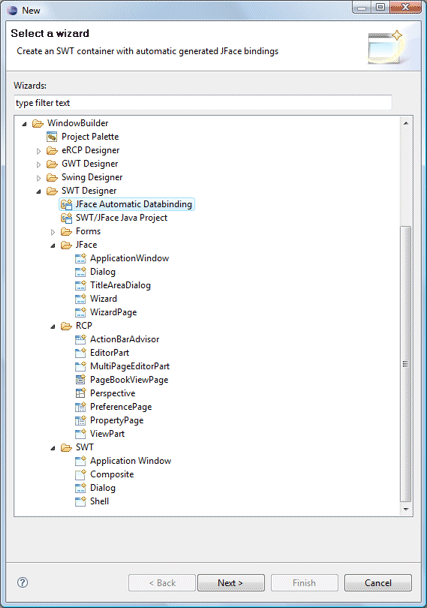
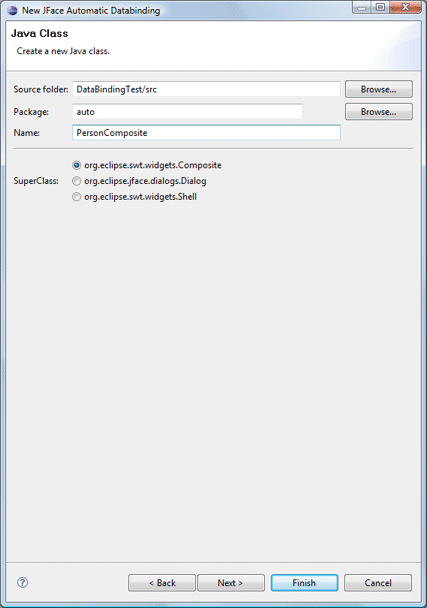
The second page of the wizard is used to specify the bean class, properties and widgets used for the new user interface. Click the "..." button to select a bean type, if it has not already been selected. The Properties list will show a list of bindable properties discovered by inspecting the class (basically any properties with getter/setter pairs with bindable data types). Next to "..." button is a filter button that can be use to show other properties that can't be bound (like class).
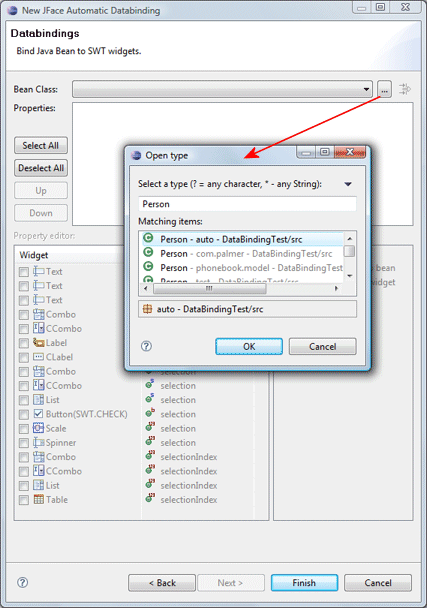
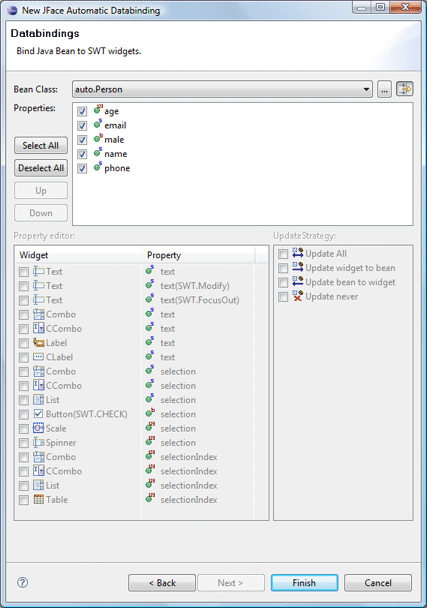
Select or deselect all of the properties using the Select All or Deselect All buttons. The order of the properties may be changed using the Up and Down buttons or via drag and drop. Check each property that should be bound to a user interface widget. Only checked properties will appear in the user interface. For each property, you can select a widget type and update strategy. String properties will be defaulted to Text widgets and Boolean properties will be defaulted to Button (CheckBox) widgets. The update strategy can be bi-directional, from widget to bean, bean to widget, or nothing. When you are satisfied with your suggestions, click Finish to generate the class.

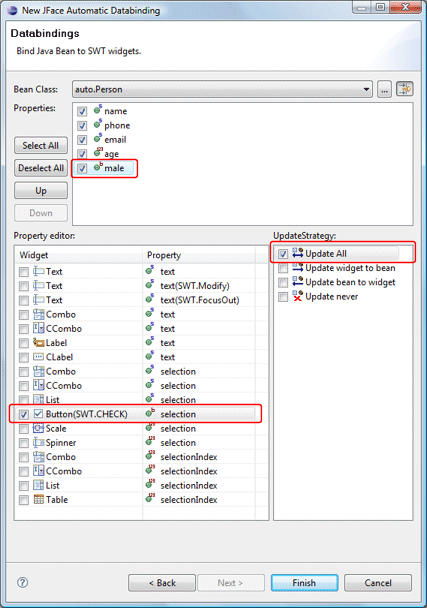
The generated user interface will consist of a two-column GridLayout with labels in the first column and editable widgets (text fields, checkboxes, spinners, etc.) in the second column. The generated layout is fully editable in the editor.
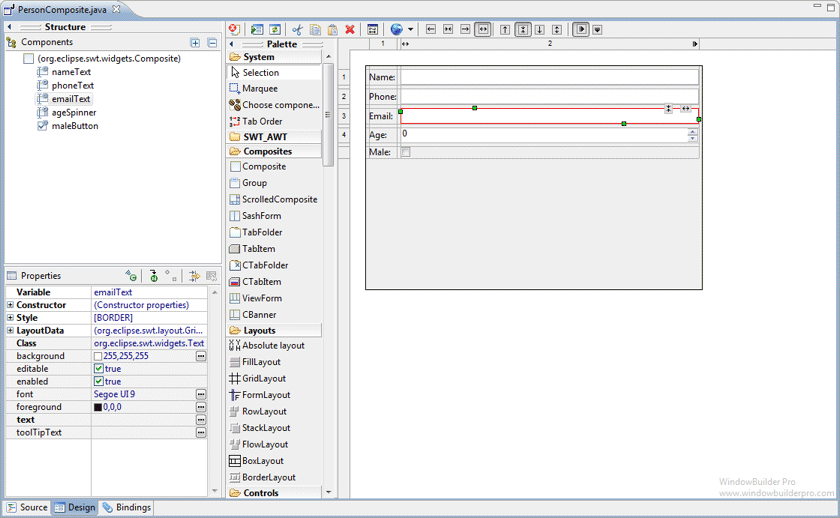
Click the Bindings tab in the WindowBuilder editor to review the generated bindings. All of the bindings may be edited and new ones added.

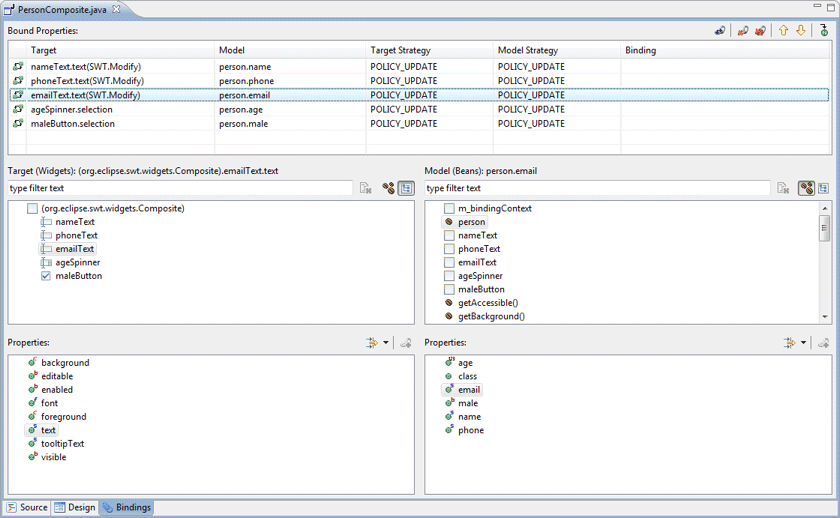
Given a data model (bean) class like this:
public class Person extends AbstractModelObject { private String m_name; private String m_phone; private String m_email; private int m_age; private boolean m_male; // public String getName() { return m_name; } public void setName(String name) { m_name = name; } public String getPhone() { return m_phone; } public void setPhone(String phone) { m_phone = phone; } public String getEmail() { return m_email; } public void setEmail(String email) { m_email = email; } public int getAge() { return m_age; } public void setAge(int age) { m_age = age; } public boolean isMale() { return m_male; } public void setMale(boolean male) { m_male = male; } }
The generated source looks like this:
import org.eclipse.core.databinding.DataBindingContext; import org.eclipse.core.databinding.beans.BeansObservables; import org.eclipse.core.databinding.observable.value.IObservableValue; import org.eclipse.jface.databinding.swt.SWTObservables; import org.eclipse.swt.SWT; import org.eclipse.swt.layout.GridData; import org.eclipse.swt.layout.GridLayout; import org.eclipse.swt.widgets.Button; import org.eclipse.swt.widgets.Composite; import org.eclipse.swt.widgets.Label; import org.eclipse.swt.widgets.Spinner; import org.eclipse.swt.widgets.Text; public class PersonComposite extends Composite { private DataBindingContext m_bindingContext; private auto.Person person = new auto.Person(); private Text nameText; private Text emailText; private Text phoneText; private Spinner ageSpinner; private Button maleButton; /** * Create the composite. * @param parent * @param style */ public PersonComposite(Composite parent, int style) { super(parent, style); // setLayout(new GridLayout(2, false)); // new Label(this, SWT.NONE).setText("Name:"); nameText = new Text(this, SWT.BORDER | SWT.SINGLE); nameText.setLayoutData(new GridData(SWT.FILL, SWT.CENTER, true, false)); // new Label(this, SWT.NONE).setText("Email:"); emailText = new Text(this, SWT.BORDER | SWT.SINGLE); emailText.setLayoutData(new GridData(SWT.FILL, SWT.CENTER, true, false)); // new Label(this, SWT.NONE).setText("Phone:"); phoneText = new Text(this, SWT.BORDER | SWT.SINGLE); phoneText.setLayoutData(new GridData(SWT.FILL, SWT.CENTER, true, false)); // new Label(this, SWT.NONE).setText("Age:"); ageSpinner = new Spinner(this, SWT.NONE); ageSpinner.setLayoutData(new GridData(SWT.FILL, SWT.CENTER, true, false)); // new Label(this, SWT.NONE).setText("Male:"); maleButton = new Button(this, SWT.CHECK); maleButton.setLayoutData(new GridData(SWT.FILL, SWT.CENTER, true, false)); // m_bindingContext = initDataBindings(); } @Override protected void checkSubclass() { // Disable the check that prevents subclassing of SWT components } private DataBindingContext initDataBindings() { IObservableValue nameObserveWidget = SWTObservables.observeText(nameText, SWT.Modify); IObservableValue nameObserveValue = BeansObservables.observeValue(person, "name"); IObservableValue emailObserveWidget = SWTObservables.observeText(emailText, SWT.Modify); IObservableValue emailObserveValue = BeansObservables.observeValue(person, "email"); IObservableValue phoneObserveWidget = SWTObservables.observeText(phoneText, SWT.Modify); IObservableValue phoneObserveValue = BeansObservables.observeValue(person, "phone"); IObservableValue ageObserveWidget = SWTObservables.observeSelection(ageSpinner); IObservableValue ageObserveValue = BeansObservables.observeValue(person, "age"); IObservableValue maleObserveWidget = SWTObservables.observeSelection(maleButton); IObservableValue maleObserveValue = BeansObservables.observeValue(person, "male"); // DataBindingContext bindingContext = new DataBindingContext(); // bindingContext.bindValue(nameObserveWidget, nameObserveValue, null, null); bindingContext.bindValue(emailObserveWidget, emailObserveValue, null, null); bindingContext.bindValue(phoneObserveWidget, phoneObserveValue, null, null); bindingContext.bindValue(ageObserveWidget, ageObserveValue, null, null); bindingContext.bindValue(maleObserveWidget, maleObserveValue, null, null); // return bindingContext; } public void setBean(auto.Person bean) { person = bean; if (m_bindingContext != null) { m_bindingContext.dispose(); m_bindingContext = initDataBindings(); } } }